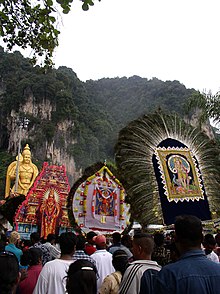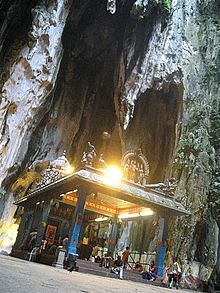Batu Caves
| Batu Caves | |
|---|---|
 Entrance to Batu Caves with the Lord Murugan statue | |
| Religion | |
| Affiliation | Hinduism |
| District | Gombak |
| Deity | Murugan |
| Location | |
| State | Selangor |
| Country | Malaysia |
 Location in Malaysia | |
| Geographic coordinates | 3°14′14.64″N 101°41′2.06″E / 3.2374000°N 101.6839056°ECoordinates: 3°14′14.64″N 101°41′2.06″E / 3.2374000°N 101.6839056°E |
| Architecture | |
| Type | Dravidian Architecture |
| Completed | 1891 |
| Website | |
| batucaves | |

Batu Caves (Tamil: பத்து மலை : Pathumalai) is a limestone hill that has a series of caves and cave temples in Gombak, Selangor, Malaysia. It takes its name from the Malay word batu, meaning 'rock'.[1] The hill was originally known as Kapal Tanggang from the legend of Si Tanggang.[2] The town nearby is named after the Batu Caves limestone formation.
The cave is one of the most popular Hindu shrines outside India, and is dedicated to Lord Murugan. It is the focal point of the Tamil festival of Thaipusam in Malaysia.
Batu Caves in short also referred as 10th Caves or Hill for Lord Muruga as there are six important holy shrines in India and four more in Malaysia. The three others in Malaysia are Kallumalai Temple in Ipoh, Tanneermalai Temple in Penang and Sannasimalai Temple in Malacca.
History[]

The limestone forming Batu Caves is said to be around 400 million years old. Some of the cave entrances were used as shelters by the indigenous Temuan people (a tribe of Orang Asli).
As early as 1860, Chinese settlers began excavating guano for fertilising their vegetable patches. However, they became famous only after the limestone hills were recorded by colonial authorities including Daly and Syers as well as American Naturalist, William Hornaday in 1878.
Batu Caves was promoted as a place of worship by K. Thamboosamy Pillai, an Indian Tamil trader. He was inspired by the vel-shaped entrance of the main cave and was inspired to dedicate a temple to Lord Murugan within the caves. In 1890, Pillai, who also founded the Sri Mahamariamman Temple, Kuala Lumpur, installed the murti (consecrated statue) of Sri Murugan Swami in what is today known as the Temple Cave. Since 1892, the Thaipusam festival in the Tamil month of Thai (which falls in late January/early February) has been celebrated there.
Wooden steps up to the Temple Cave were built in 1920.In the 1930s, the stairs began to show signs of wear and tear, and then temple chairman Ramachandran Naidu proposed to build two flights of concrete stairs to the upper caves. The proposal was forwarded to Sorobgom in 1939. The work was completed in 1940, just in time for the Thaipusam celebration that year according to current temple Chairman R. Nadarajah.[3]Currently there are 272 concrete steps. Of the various cave temples that comprise the site. The largest and best known is the Temple Cave, so named because it houses several Hindu shrines beneath its high vaulted ceiling.
On 1 September 1942, a village near the Caves was the site of a Communist Party of Malaya meeting convened by Lai Teck, which included the CPM's Central Executive Committee, state party officials, and a group leaders of the MPAJA. However, Lai Teck betrayed the meeting to the Japanese, whom staged a surprise raid at dawn, destroying most of the CPM and MPAJA high command.
In August 2018 the 272 steps were painted in an extraordinary colour scheme, with each set of steps painted in a different range of colours. However, accusations were almost immediately made by the National Heritage Department for a breach of law requiring authorisation for renovations within 200 metres of a heritage site. The temple's management disputed their failure to receive authorisation.[4][5]
Religious site[]

Rising almost 100 m above the ground, the Batu Caves temple complex consists of three main caves and a few smaller ones. The biggest, referred to as Cathedral Cave or Temple Cave, has a very high ceiling and features ornate Hindu shrines. To reach it, visitors must climb a steep flight of 272 steps.
At the base of the hill are two more cave temples, Art Gallery Cave and Museum Cave, both of which are full of Hindu statues and paintings. This complex was renovated and opened as the Cave Villa in 2008. Many of the shrines relate the story of Lord Murugan's victory over the demon Soorapadman. An audio tour is available to visitors.
The Ramayana Cave is situated to the extreme left as one faces the sheer wall of the hill. On the way to the Ramayana Cave, there is a 15 m (50 ft) tall statue of Hanuman and a temple dedicated to Lord Hanuman, devotee and aide of Lord Rama. The consecration ceremony of the temple was held in November 2001.
The Ramayana Cave depicts the story of Rama in a chronicle manner along the irregular walls of the cave.
A 42.7-metre (140 ft) high statue of Lord Murugan was unveiled in January 2006, having taken 3 years to construct. It is the tallest Lord Murugan statue in the world.
Administration[]
Batu Malai Sri Murugan Temple is managed by the Board of Management of Sri Maha Mariamman Temple Devasthanam, which also manages the Sri Mahamariamman Temple, Kuala Lumpur and the Kortumalai Pillaiyar Temple. It also performs the role of Hindu Religious Consultant to the Government of Malaysia in determining the Hindu yearly calendar.
Nature, flora and fauna[]
The Batu Cave hill and its numerous caverns contain a wealth of plants and animals, many of which are specialised for limestone environments. A total of 269 species of vascular plants have been recorded from the site, including 56 species (21%) which are obligate calciphiles (found only on limestone).[6]
There are various undeveloped caves which contain a diverse range of cave fauna, including some unique species, such as trapdoor spiders (Liphistius batuensis).[7] The caves have some 21 species of bats, including several species of fruit bats (Eonycteris).[2] The site is also well known for its numerous long-tailed macaques, which visitors feed — sometimes involuntarily. These monkeys may also pose a biting hazard to tourists (especially small children) as they can be quite territorial.
Below the Temple Cave is the Dark Cave, with rock formations and a number of animals found nowhere else. It is a two-kilometer network of relatively untouched caverns. Stalactites jutting from the cave's ceiling and stalagmites rising from the floor form intricate formations such as cave curtains, flowstones, cave pearls and scallops which took thousands of years to form.
In order to maintain the cave's ecology, access is restricted. The Malaysian Nature Society organises regular educational and adventure trips to the Dark Wet Caves.
Rock climbing[]

Batu Caves is also the centre of rock climbing development in Malaysia for the past 10 years. Batu Caves offers more than 160 climbing routes.[8] The routes are scattered all around the side of Batu Caves, which is made up of limestone hills rising to 150 m. These climbing routes are easily accessed, as most crags start from ground level. These climbing routes often start from the North Eastern side of the cave complex whereas the staircase and temple entrance faces South. This Northeastern area is known as the Damai caves. Abseiling and spelunking trips can be organised with some local adventure companies.
Festivals[]

The Batu Caves serve as the focus of the Tamil community's yearly Thaipusam (Tamil: தைபூசம்) festival. They have become a pilgrimage site not only for Malaysian Hindus, but Hindus worldwide.
A procession begins in the wee hours of the morning on Thaipusam from the Sri Mahamariamman Temple, Kuala Lumpur leading up to Batu Caves as a religious undertaking to Lord Muruga lasting eight hours. Devotees carry containers containing milk as offering to Lord Murugan either by hand or in huge decorated carriers on their shoulders called 'Kavadi'.
The kavadi may be simple wooden arched semi-circular supports holding a carrier foisted with brass or clay pots of milk or huge, heavy ones which may rise up to two metres, built of bowed metal frames which hold long skewers, the sharpened end of which pierce the skin of the bearers torso. The kavadi is decorated with flowers and peacock feathers imported from India. Some kavadi may weigh as much as a hundred kilograms.
After bathing in the nearby Sungai Batu (Rocky River), the devotees make their way to the Temple Cave and climb the flights of stairs to the temple in the cave. Devotees use the wider centre staircase while worshippers and onlookers throng up and down those balustrades on either side.
When the kavadi bearer arrives at the foot of the 272-step stairway leading up to the Temple Cave, the devotee has to make the arduous climb.
Priests attend to the kavadi bearers. Consecrated ash is sprinkled over the hooks and skewers piercing the devotees' flesh before they are removed. No blood is shed during the piercing and removal.[citation needed]
Development[]

Housing development began around 1970 with housing estates such as Taman Batu Caves, Taman Selayang, Taman Amaniah, Taman Sri Selayang, Taman Medan Batu Caves, and Taman Gombak Permai.
In the last decade, the surrounding area has changed from a small village to industrial estates, new housing, and retail. There is also an elevated flyover across the highway. A new 515-million-ringgit KTM Komuter rail extension from Sentul to Batu Caves began operations in July 2010, serving the rebuilt Batu Caves Komuter station.
On 1 January 2011, during the Thaipusam festival, it was announced that a cable car would be built for the following year's festival. It would cost around 10 million ringgit.[9][10]
Transportation[]
Batu Caves is easily reached by commuter train at the KC05 Batu Caves Komuter station, costing RM 2.6 for a one-way journey from KA01 KS01 KJ15 MR1 KE1 KT1 SBK15 KL Sentral. Batu Caves may also be reached by bus 11/11d from Bangkok Bank Terminus (Near to Puduraya Terminus) or bus U6 from Titiwangsa. Batu Caves is also easily reached by travelling by car.
See also[]
- Malaysian Indian
- Indian Singaporean
- Kavadi
References[]
- ^ Lim, Teckwyn; Yussof, Sujauddin; Ashraf, Mohd. (2010). "The Caves of Batu Caves: a Toponymic Revision". Malayan Nature Journal. 62: 335–348.
- ^ Jump up to: a b Ong, Dylan Jefri (2020). Kiew, Ruth; Zubaid Akbar Mukhtar Ahmad; Ros Fatihah Haji Muhammad; Surin Suksuwan; Nur Atiqah Abd Rahman; Lim Teck Wyn (eds.). Batu Caves: Malaysia's Majestic Limestone Icon. Kuala Lumpur: Malaysian Cave and Karst Conservancy. p. 44. ISBN 978-967-17966-0-3.
- ^ Tajuddin, Iskandar (2016-01-24). "'It began with prayer to Lord Muruga' | New Straits Times". NST Online. Retrieved 2021-06-05.
- ^ Bavani, M. (30 August 2018). "Batu Caves temple committee steps into trouble". Star. Retrieved 31 August 2018.
- ^ "Temple gets stunning paint job (shame it might be illegal)". BBC. 31 August 2018. Retrieved 31 August 2018.
- ^ Kiew, Ruth (2014-09-12). "Checklist of vascular plants from Batu Caves, Selangor, Malaysia". Check List. 10 (6): 1420–1429. doi:10.15560/10.6.1420. ISSN 1809-127X.
- ^ T.W. Lim and S.S. Yussof (2009). "Conservation status of Batu Caves Trapdoor Spider (Liphistius batuensis Abraham (Araneae, Mesothelae)): A preliminary survey. 61: 121-132". Malayan Nature Journal. 62 (1): 121–132.
- ^ ("Rock Climbing @ Batu Caves".Xes
- ^ "Cable car service in Batu Caves next year". New Straits Times. Kuala Lumpur. 16 January 2011. Archived from the original on 29 June 2011. Retrieved 14 April 2011.
- ^ "RM10 mil cable car for Batu Caves". Malaysia Kini. 20 January 2011. Retrieved 14 April 2011.
External links[]
| Wikimedia Commons has media related to Batu Caves. |
- Hindu temples in Malaysia
- Caves of Malaysia
- Limestone caves
- Hindu pilgrimage sites
- Hindu cave temples of Malaysia
- Nature sites of Selangor
- Religious buildings and structures in Selangor
- Landforms of Selangor
- Climbing areas

